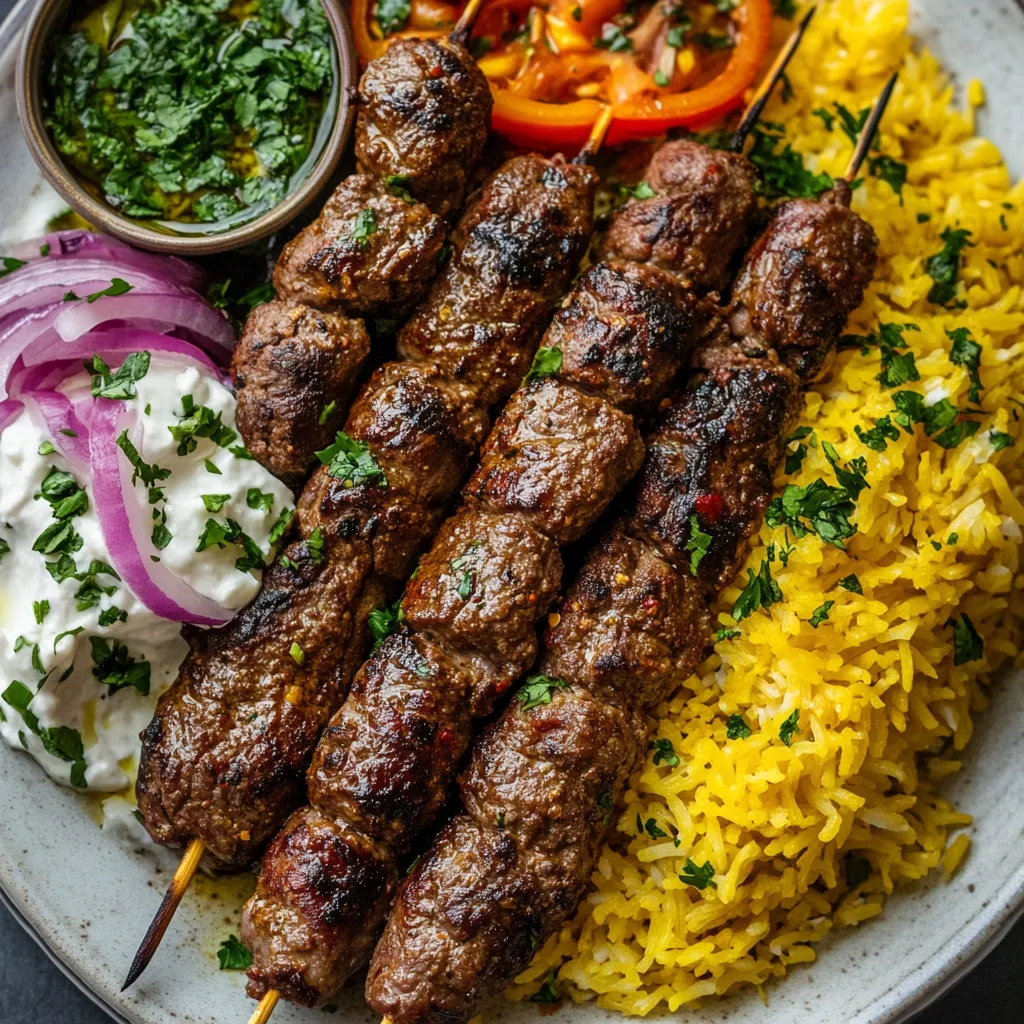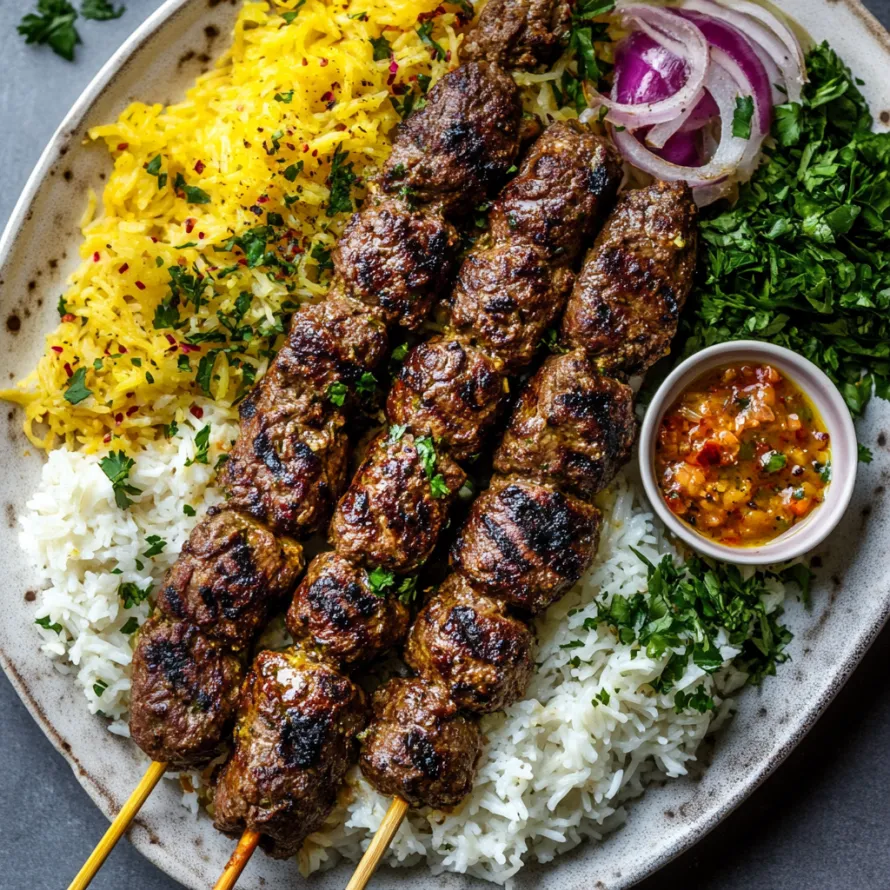 Save
Save
For years now, this classic Persian ground beef kebab has been my favorite choice when hosting summer get-togethers or any big event. You'll fall in love with the expertly spiced beef that's wrapped on flat skewers then grilled until juicy—bringing genuine Middle Eastern tastes straight to your home cooking.
I first tried making Koobideh when my Persian buddy had a birthday party, and when he tasted it, he got so emotional about having something that reminded him of his homeland that I knew I had to add this to my regular cooking lineup.
Ingredients
- Ground beef: Go with 80/20 meat-to-fat balance for the juiciest results and proper texture
- Onion: Adds needed moisture and forms the key flavor foundation for real Koobideh
- Garlic cloves: Brings richness without taking over the meat's taste
- Paprika: Gives a nice hint of color and gentle pepper notes
- Sumac: Can't skip this—it gives that bright tangy kick that makes Persian food special
- Kosher salt: Lifts all the flavors and helps everything stick together
- Black pepper: Grind it fresh for maximum punch
- Ground turmeric: Brings golden color and subtle earthiness
- Saffron: The star Persian element that creates that unforgettable smell and yellow-orange tint
- Butter or olive oil: Creates that shiny finish and keeps everything moist
How To Make It
- Deal with the onion:
- Use your box grater to shred the onion finely, then push out the extra juice through a mesh strainer or squeeze with a kitchen towel. This keeps your meat mix from getting soggy while still getting all that good onion flavor.
- Mix your meat:
- Put the ground beef in a big bowl with your drained onion, chopped garlic, and all your spices. Get in there with your hands and mix everything really well until it feels a bit sticky. This good mixing helps the proteins bind so your meat won't fall off the skewers.
- Let it chill:
- Pop your meat mixture in the fridge for at least 2 hours. This super important step lets the proteins come together and chills the fat, making it way easier to shape onto skewers without dropping off during cooking.
- Make saffron water:
- Smash your saffron threads with the back of a spoon to release the oils, then toss in some ice cubes to pull out the most color and flavor. This cold method actually gets more saffron goodness than using hot water.
- Whip up saffron butter:
- Melt some butter in a small pot and stir in your saffron water. This makes an amazing golden liquid you'll brush on your kebabs for awesome flavor and color.
- Shape your kebabs:
- Grab some of your cold meat mix and carefully press it around flat metal skewers, making sure it's about half inch thick all around. Use your thumb and finger to make those classic ridge patterns down the length.
- Cook with patience:
- Put your kebabs on a nice hot medium-high grill and don't touch them for 3-4 minutes before you try flipping. This first cooking time helps the meat stick to the skewer.
- Brush with your golden butter:
- When your kebabs are almost done, brush them generously with your saffron butter on both sides. This adds incredible taste and makes them look glossy and appetizing.
- Cook the veggies:
- While your meat rests, throw some tomatoes, onions, and peppers on the grill with a bit of olive oil until they get nice char marks and turn soft.

Sumac really steals the show in this dish for me. Its bright, lemon-like kick balances out the rich meat perfectly. The first time I made this for my family, even my father-in-law, who hardly ever comments on food, specifically asked what gave everything that zingy taste that made it all so lively.
No Special Skewers Needed
Don't worry if you can't find those traditional flat Persian skewers. Just shape your meat mix into long oval patties about 5 inches in length and an inch thick. You can cook them right on your grill grates or in a cast iron pan with a touch of oil. They won't have that classic look, but they'll taste just as amazing. Serve them with some rice and grilled veggies, and nobody will miss the skewers.
Traditional Serving Ideas
The classic way to enjoy Koobideh is with bright yellow saffron rice and charred tomatoes fresh off the grill. To go all out with a full Persian spread, add some Mast o Khiar (cucumber yogurt with herbs), a plate of fresh herbs like mint and basil, some radishes, and soft lavash bread. Finish everything with a light dusting of sumac. Try adding a simple side of chopped cucumbers, tomatoes and red onions tossed with fresh lemon juice and olive oil for a cool contrast.
What It Means In Persian Culture
Koobideh isn't just food in Persian culture—it's tradition. The name comes from "koobidan" which means "to pound" in Persian, pointing to how folks used to prepare it by pounding meat with wooden mallets until super fine. You'll find this dish at pretty much every Persian celebration. In traditional Iranian eateries, the kebab experts take serious pride in making perfectly uniform kebabs that stay on the skewer without falling apart—that's how you spot a true master of Persian cooking.

This dish really does bring a taste of Persian heritage and cooking traditions to your dinner table—it's both incredibly tasty and genuinely authentic.
Common Recipe Questions
- → Why do I need to refrigerate the meat mixture for 2 hours?
Chilling the meat mix is crucial because it lets the fat harden, which makes the mixture stick together better when you put it on skewers. This cool-down step keeps the meat from dropping off while cooking and helps maintain the signature shape that makes Koobideh kebabs so recognizable.
- → Can I use regular skewers instead of flat Persian skewers?
Flat Persian skewers work best as they keep the meat from spinning and spread heat more evenly, but you can still enjoy Koobideh without them. Just shape the meat into long cylinders by hand and cook them directly. The flavor will stay authentic, though they won't look exactly like traditional ones.
- → What is sumac and is there a substitute?
Sumac gives food a bright, lemony kick and is a staple in Middle Eastern dishes that creates the unique taste of Koobideh. If you can't find it, mix some lemon zest with paprika instead, but know the real flavor will be a bit different. Your best bet is checking ethnic food stores or shopping online for the real thing.
- → How do I create the signature ridges on the kebabs?
To make those famous grooves on Koobideh kebabs, just press your thumb and pointer finger into the meat in a pattern after you've shaped it around the skewer. This doesn't just make them look right—it also helps them cook better by creating spots where the meat is thinner.
- → Can I prepare the meat mixture in advance?
You can definitely mix up the meat a day ahead and store it in the fridge. This extra time actually makes it taste better since the spices get more time to blend with the meat. Just wrap it up tight so it doesn't dry out or pick up weird smells from other foods in your fridge.
- → What's the purpose of the saffron butter?
The saffron butter works magic as a finishing touch, adding moisture and rich flavor to the kebabs. It carries the special smell and taste of saffron through the meat and gives it a nice golden color too. We brush it on near the end of cooking so it won't burn but still adds tons of flavor.
